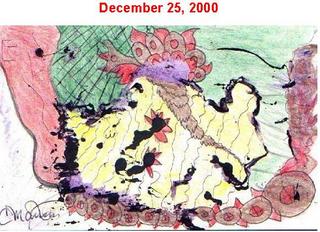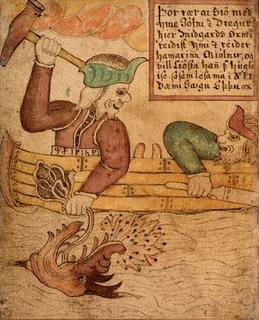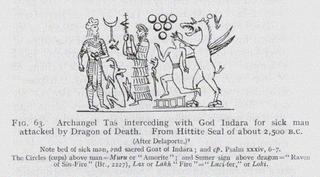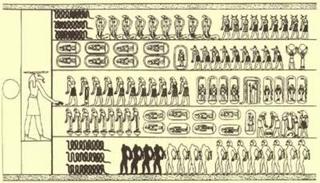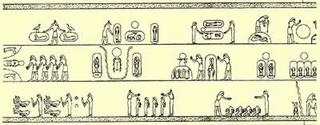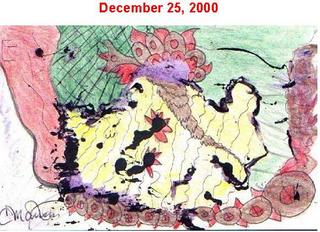let's embark on a little exercise called "gossamer wings" . . .Thor is depicted as responsive to human distress which is not a quality widely associated with warfare. This is most clearly shown in the myth of his journey to Utgard with Loki when he stopped at a peasant's farm on the way. He killed his goats to provide a meal for them all but instructed them to be sure to save the bones and skin. The next morning before dawn he passed Mjollnir, his magical hammer, over the bones on the skin and brought his goats back to life but noticed that one was lame (where the farmer's son had ignored instructions and broken a bone to get at the marrow). This kindled his wrath and his eyes took on his truly awesome stare. The terrified farmer and his family offered all they had to atone but when Thor saw their terror he calmed down and accepted the children as bondservants. Thor's temper can be regained as fast as it is lost - the cold implacability that sweeps all before it in war is not there. In historical terms, Thor derives from a very early deity: the Indo-European weather god. This being was described as male with red hair and a beard, a tremendous appetite and as possessing thunderbolts. This weather god was also described as being the protector of mankind and slayer of serpent(s). Even the Hindu god Indra, whose roots are in the Indo- European tradition, shows these characteristics. This may be why Snorri Sturluson, in the early part of the Prose Edda where he talks of the gods and goddesses as historical humans, says Odin was a descendant of Thor and not the other way round as might be expected. There is an etymological link to the Celtic deity Jupiter Tanarus as the Germanic forms of the thunder god's name are believed to have derived from this 'thundering' Jupiter. In Anglo-Saxon England he was Thunar, in continental Germany he was Donar (or Donner) and in Scandinavia and their Viking Settlements he was Thor. The tales of rough roistering and heroic deeds ascribed to Thor have led scholars to identify him with the early Germanic god written of by the Roman historian Tacitus as the Latin demi-god Hercules. Tacitus wrote of three main gods in the German tribes in terms of their classical counterparts. Later analogies were made to the Sky Father, Jupiter.  . . . In the literary work of the Icelandic Eddas and middle high German Nibelunglied, Thor/Donar is one of the prominent Male deities with Odin/Wodan and Tyr/Teiwaz. Adam of Bremen wrote that 'they say he rules the air which controls the thunder and the lightning, the winds and showers, the fair weather and the fruits of the earth'. Thor has the power to bestow fertility as he is the son of Mother Earth (his belt of strength is called Meginjard or 'Earth Power' ), the controller of the weather and the wielder of Mjollnir. The hammer is especially important to this power.[emphasis added, thX to Ben-O]association of Tyr with Jupiter/Zeus and "Men" recalls Rudyard Kipling's "Song of the Men's Side":Once we feared The Beast - when he followed us we ran,Ran very fast though we knewIt was not right thatThe Beast should master Man;But what could we Flint-workers do?The Beast only grinned at our spears round his ears -Grinned at the hammers that we made;But now we will hunt him for the life with the Knife-And this is the Buyer of the Blade! Room for his shadow on the grass - let it pass!To left and right - stand clear!This is the Buyer of the Blade - be afraid!This is the great God Tyr! Tyr thought hard till he hammered out a plan,For he knew it was not right (And it is not right)that The Beast should master Man;So he went to the Children of the Night.He begged a Magic Knife of their make for our sake.When he begged for the Knife they said:'The price of the Knife you would buy is an eye!'And that was the price he paid. Tell it to the Barrows of the Dead - run ahead!Shout it so the Women's Side can hear!This is the Buyer of the Blade - be afraid!This is the great God Tyr! Our women and our little ones may walk on the Chalk,As far as we can see them and beyond.We shall not be anxious for our sheep when we keepTally at the shearing-pond.We can eat with both our elbows on our knees, if we please,We can sleep after meals in the sun;For Shepherd-of-the-Twilight is dismayed at the Blade,Feet-in-the-Night have run!Dog-without-a-Master goes away (Hai, Tyr aie!),Devil-in-the-Dusk has run! Then: Room for his shadow on the grass - let it pass!To left and right - stand clear!This is the Buyer of the Blade - be afraid!This is the great God Tyr!this from Wikipedia (which also provided the illustrations and caption):
. . . In the literary work of the Icelandic Eddas and middle high German Nibelunglied, Thor/Donar is one of the prominent Male deities with Odin/Wodan and Tyr/Teiwaz. Adam of Bremen wrote that 'they say he rules the air which controls the thunder and the lightning, the winds and showers, the fair weather and the fruits of the earth'. Thor has the power to bestow fertility as he is the son of Mother Earth (his belt of strength is called Meginjard or 'Earth Power' ), the controller of the weather and the wielder of Mjollnir. The hammer is especially important to this power.[emphasis added, thX to Ben-O]association of Tyr with Jupiter/Zeus and "Men" recalls Rudyard Kipling's "Song of the Men's Side":Once we feared The Beast - when he followed us we ran,Ran very fast though we knewIt was not right thatThe Beast should master Man;But what could we Flint-workers do?The Beast only grinned at our spears round his ears -Grinned at the hammers that we made;But now we will hunt him for the life with the Knife-And this is the Buyer of the Blade! Room for his shadow on the grass - let it pass!To left and right - stand clear!This is the Buyer of the Blade - be afraid!This is the great God Tyr! Tyr thought hard till he hammered out a plan,For he knew it was not right (And it is not right)that The Beast should master Man;So he went to the Children of the Night.He begged a Magic Knife of their make for our sake.When he begged for the Knife they said:'The price of the Knife you would buy is an eye!'And that was the price he paid. Tell it to the Barrows of the Dead - run ahead!Shout it so the Women's Side can hear!This is the Buyer of the Blade - be afraid!This is the great God Tyr! Our women and our little ones may walk on the Chalk,As far as we can see them and beyond.We shall not be anxious for our sheep when we keepTally at the shearing-pond.We can eat with both our elbows on our knees, if we please,We can sleep after meals in the sun;For Shepherd-of-the-Twilight is dismayed at the Blade,Feet-in-the-Night have run!Dog-without-a-Master goes away (Hai, Tyr aie!),Devil-in-the-Dusk has run! Then: Room for his shadow on the grass - let it pass!To left and right - stand clear!This is the Buyer of the Blade - be afraid!This is the great God Tyr!this from Wikipedia (which also provided the illustrations and caption):Tyr/Tiw had become relatively unimportant compared to Odin/Woden in both North and West Germanic. Traces of the god remain, however, in
Tuesday ("Tiw's day"), named after Tyr in both the North and the West Germanic languages (corresponding to Martis dies, dedicated to the Roman god of war,
Mars) . . .
 Týr is identified with Mars in this illustration from an 18th century Icelandic manuscript.
Týr is identified with Mars in this illustration from an 18th century Icelandic manuscript.
. . . which led to this from today's Yahoonews (though datelined Monday):Eyes to the sky for the Mars spectacular
Mon Oct 24, 5:49 PM ET
PARIS (AFP) - The last time Mars swung so close to Earth, Hindu seers foretold of war, European astrologers predicted love and Germany reported a rash in UFO sightings.
Thus is the spell cast by planetary alignment, so extreme predictions and odd events seem entirely possible this week as Mars and Earth edge together once more.
what'd be "odd" would be a bit o' normalcy!On Sunday, October 30, the Red Planet will be 69.4 million kilometers (43.1 million miles) from Earth -- a distance that in galactic terms is less than wafer-thin and will not be equalled until 2018.
Skywatchers are rubbing their hands at the opportunity.
In the runup to Sunday, but also for much of November, Mars will appear as a big orangey-yellow "star" in the east, an object so bright that it should be visible in almost any conditions of light pollution, says the US publication Sky & Telescope.
Weather permitting -- on Earth and also on Mars, where there are some worrying signs of an impending dust storm -- anyone with a modest telescope should be able to pick out some of the features that make Mars so special.
According to the French magazine Ciel et Espace, anyone who invests in a small 60mm (two-inch) -diameter telescope, priced in many countries at around 150 euros (180 dollars), should be easily able to spot Syrtis Major, Mars' most recognisable characteristic.
an anagram of "Tyr Sis"This vast region of cratered plateaux appears as a dark, roughly triangular-shaped tongue whose point heads towards Mars' North Pole.
hmm . . . more with the snakelike tongue . . .They should also be able to make out Helas, a vast impact crater that is often covered by whitish mist and is sometimes mistaken for Mars' southern polar icecap.
"Helas" is fairly close to "Helios" (see below)"Helas" is also an anagram for "selah," a Psalmist term associated with musical "arrangement" and praiseInvest a couple of thousand euros (dollars) or more to get a telescope with a diametre of 200mm (eight inches) or more -- or go to your nearest observatory or visit an astronomy website -- and some really hunky stuff comes into view.
For size, nothing beats Mons Olympus, 26,000 metres (84,500 feet) high -- the biggest volcano in the Solar System. And Arizona's Grand Canyon would fit snugly inside Valles Marineris -- seven kms (four miles) deep and 200 kms (120 miles) across.
"biggest volcano in the solar system"Mars' southern pole, seasonally shrunk by summer heat, will appear as a brilliant white dot. And with luck, one night you may bag Mars' tiny moons, Phobos and Deimos, which once were asteroids until they were captured by the Martian gravity.
Mars' moons are mentioned in Kin Notes, a companion document for Qim TunesOn August 27, 2003, Earth and Mars were a mere 55.76 million kms (34.65 million miles) apart, the closest in almost 60,000 years.
This time, the planets are slight farther apart, but the viewing prospects are better than in 2003, says the Institute of Celestial Mechanics at the Paris Observatory.
This is because, in 2003, Mars' course barely took it above the horizon for viewers in Earth's northern hemisphere, which meant the image was distorted by light passing through the atmosphere.
Earth, the third planet from the Sun, takes 365 and a quarter days to go around its star. Mars, the fourth planet, takes 687 Earth Days.
That means they come close every 26 months or so. But both planets take a slightly elliptical path around the Sun, and this factor determines precisely how close the flyby will be.
The next time the planets will be closer than in 2003 will be in 2287.
Mars figures prominently in the online autistic document, Qim Tunes, and autistic poet Jeffrey Powell, Jr., includes both Mars and Jupiter in his amazing "In Jupiter's Realm Waiting":
In light of hopeless voices changes can't be avoided,
I'm staying in the likeness of molten calm.
It's hot in the crater, but like stopped stone on the surfaces,
I'm hoping to master my knoll of Jupiter soon.
It is like the oldest godlike firths in the deepest recesses.
Great thunder rolling after the firestorm,
warning that the dragons still wait and watch.
But giving the dreamer hope that they will not find the opening
as long as the stony surface remains still.
The rain has gentled as have his tears.
The extra fair lady Ann is leaving on the seaworthy voyage
and will be in Poseidon's realm not Jupiter's.
Often the myths are the same, but it is always known
the Romans and Greeks were fortunes apart and destinies different
Fair to drink the wine of Vulcan, but can't feed on the ambrosia.
Three ways freedom could be won and that one remains closed.
Bitterness must be held back.
It is now understood to be the weapon of the enemy.
In the path of Mars I will search outward for Aphrodite.
And hopes and dreams of the muses will hold a tender candle for me
till the orbits carry the life of one into the path of Greek freedom and enlightenment.
And the fires of Vulcan are quenched with the fair Grecian urn of contentment and saving simplicity.
Dreams are like paintings,
still and yet rimmed with color and light,
expressions of the painter's passion.
Come forth Helios lover of Aurora.
finally -- well, sorta "finally" lol -- here's a Cat Stevens song from one of my favorite albums, 1971's Teaser and the Firecat, which I listened to incessently while at military tech school:
If I make a mark in time I can't say the mark is mine
I'm only the underline of the word
Yes, I'm like him, just like you
I can't tell you what to do
Like everybody else I'm searching through what I've heard
Whoa! -- where do you go
when you don't want no one to know?
Who told tomorrow -- Tuesday's dead?
Oh preacher won't you paint my dream
won't you show me where you've been,
show me what I haven't seen to ease my mind
'Cause I will learn to understand
If I have a helping hand
I wouldn't make another demand, all my life
Whoa! -- where do you go
when you don't want no one to know?
Who told tomorrow -- Tuesday's dead?
What's my sex, what's my name?
all in all it's all the same
everybody plays a different game -- that is all
Now man my live, man may die
searching for the question why,
but if he tries to rule the sky, he must fall
Whoa! -- where do you go
when you don't want no one to know?
who told tomorrow -- Tuesday's dead?
Now every second on the nose
The humdrum of the city grows
reaching out beyond the throes of our time.
We must try to shake it down
Do our best to break the ground
try to turn the world around one more time
Yes, we must try to shake it down
do our best to break the ground
try to turn the world around one more time
Whoa!-- where do you go
when you don't want no one to know?
Who told tomorrow -- Tuesday's dead?
Cat once commented:
I get the tune and then I just keep on singing the tune until the words come out from the tune. It's kind of a hypnotic state that you reach after a while when you keep on playing it where words just evolve from it.
In "Tuesday's Dead," he appears to be prophesying a number of things, including the death of the deity Tiwaz, Tas, Tyr, etc. -- or, perhaps, the narrator is questioning the "veracity" of the future ("tomorrow").
The reference to man trying to "rule the sky" is illustrative, as Tyr is a thunder/lightning/sky god, and the species has embarked on both flight and extraterrestrial travel/exploration/conquest. But its the element of "conquest" most at issue here, literal "rule" of the sky/heaven/the mind, a new Tower in a new Babylon.
The verse containing the "preacher painting the dream" along with the "helping hand" recalls Bob Dylan's "Lo and Behold" painting, discussed in a prior post. As here, the theme there is song, or great art in general, as the driving force or catalyst preceding manifest creation/destruction.
The half-ironic "Where do you go/when you don't want no one to know" refers to being under the "observation of heaven" and to the relative "sanctity" of the individual mind/consciousness.
As for the "mark" in time comment, it's also an ironic reference to "Tiwzday," which I'll leave to the Deer Reeder to decipher . . . .
Given Cat's conversion to Islam following a near-death experience, and his re-creation as "Yusuf Islam," we must look closely at the lines, "We must try to shake it [the city] down . . . do our best to break the ground."
On 21 September 2004, Cat/Yusuf was denied entry into the U.S. and deported to England, on grounds of "concerns of ties he may have to potential terrorist-related activities."
The prophecy of "Tuesday's Dead," then, could concern the removal, passing, or hiding of the Western-deity "Tyr's" protection over his nation(s), possibly in relation to man's attempt to "rule the sky " (i.e., heaven in physical terms). Whether in the pre-reality of Bob Dylan's "Lo and Behold" or the post-reality of New York's Ground Zero, what follows as consequence of an over-reaching desire to "rule" is the "ground breaking" and the "shaking down" of the City.
The song "Tuesday's Dead" is kin to another of Cat's songs, the hypno-chant "Longer Boats" from 1970's Tea for the Tillerman. In Irish myth/folktales are numerous references to aerial "ships" called loinger demnacda. One of the song's lines runs, "I don't want no god on my lawn!"





